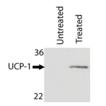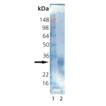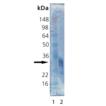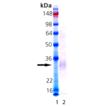-
First to market active Irisin
-
Multifunctional protein validated for activity assay, ELISA, SDS-PAGE and Western blot
-
Important regulatory protein for metabolism and neurogenesis
Product Details
| Alternative Name: | FNDC5, FRCP2 |
| |
| MW: | ~25kDa |
| |
| Source: | Produced in CHO cells. aa 32-143, also known as Irisin, comprises the majority of the extracellular domain of FNDC5. It is fused at the N-terminus to a FLAG®-tag with an 8 aa linker between the FLAG®-tag and Irisin. |
| |
| UniProt ID: | Q8NAU1 |
| |
| Formulation: | Liquid. In 1X PBS. |
| |
| Purity: | ≥90% (SDS-PAGE) |
| |
| Endotoxin Content: | <0.01EU/µg |
| |
| Biological Activity: | Treatment of 3T3L1 with 2µg/ml Irisin induces UCP-1 expression. |
| |
| Applications: | ELISA, WB
Activity assay, SDS-PAGE
|
| |
| Shipping: | Dry Ice |
| |
| Long Term Storage: | -80°C |
| |
| Use/Stability: | Stable for up to a week when stored at +4°C and at least 6 months when stored at -80°C. |
| |
| Handling: | Avoid freeze/thaw cycles. |
| |
| Scientific Background: | Irisin is a hormone that is involved in converting white adipose tissue into brown adipose tissue after physical exercise. It is formed after the membrane bound protein fibronectin type III domain containing protein 5 (FNDC5) is cleaved resulting in a secreted protein. FNDC5 is found in muscle tissue and is activated during physical exertion via the protein PGC1a. Soluble Irisin has also been shown to up regulate UCP-1 gene expression in mice. UCP-1 is a mitochondrial transporter protein and a marker of brown adipose tissue conversion. This suggests that Irisin plays an important role in energy regulation and furthermore may lead to improvements in glucose regulation, insulin sensitivity, hypertension, and obesity. |
| |
| Technical Info/Product Notes: | FLAG is a registered trademark of Sigma-Aldrich Co. |
| |
| Regulatory Status: | RUO - Research Use Only |
| |
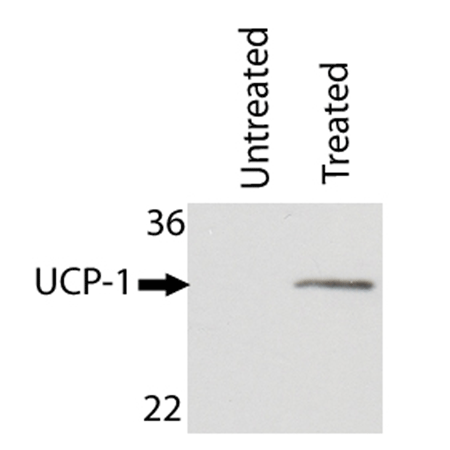
Figure 4: Stimulation of UCP-1 after treatment with Irisin (human) (rec). 3T3L1 cells were treated with or without 2µg/ml Irisin. After 48 hours the cells were lysed, normalized to total protein, and run on an SDS-PAGE. Gels were transferred to nitrocellulose and blotted against rabbit anti-UCP-1 antibody.
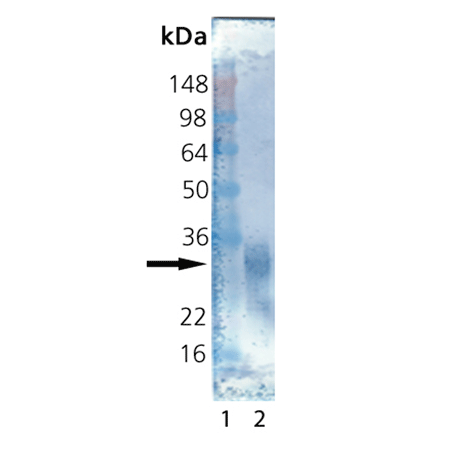
Figure 3: Western blot analysis of Irisin (human) (rec) against rabbit anti-FNDC5 antibody. Lane 1: Molecular weight marker, Lane 2: 0.1µg Irisin.
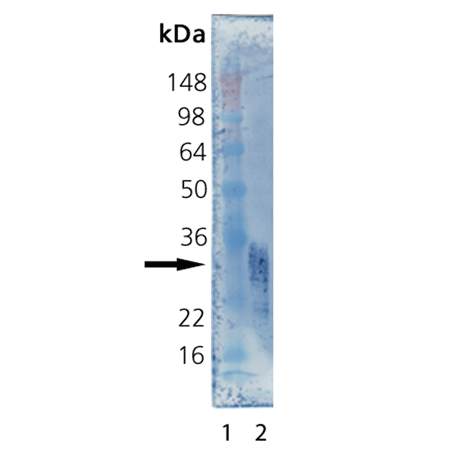
Figure 2: Western blot analysis of Irisin (human) (rec) against mouse anti-flag antibody. Lane 1: Molecular weight marker, Lane 2: 0.1µg Irisin.
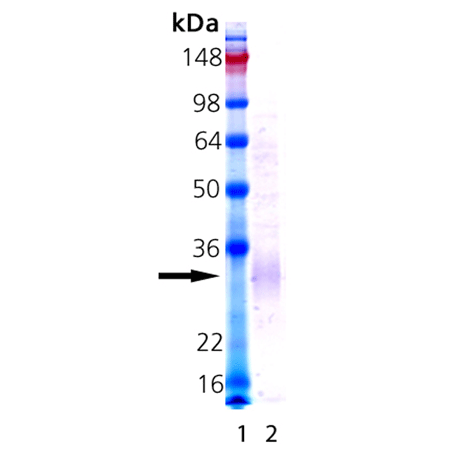
Figure 1: Coomassie stained SDS-PAGE analysis of Irisin (human) (rec). Lane 1: Molecular weight marker, Lane 2: 1µg Irisin.
Please mouse over
Product Literature References
Excessive irisin increases oxidative stress and apoptosis in murine heart: M.Y. Ho, et al.; Biochem. Biophys. Res. Commun.
503, 2493 (2018),
Abstract;
Decreased levels of irisin, a skeletal muscle cell-derived myokine, are related to emphysema associated with chronic obstructive pulmonary disease: Y. Sugiyama, et al.; Int. J. Chron. Obstruct. Pulmon. Dis.
12, 765 (2017),
Abstract;
Full Text
Irisin inhibition of growth hormone secretion in cultured tilapia pituitary cells: A. Lian, et al.; Mol. Cell Endocrinol.
439, 395 (2017),
Application(s): Molecular characteristics, tissue expression, and biological actions of irisin on GH secretion in talipia,
Abstract;
Inhibition of myostatin in mice improves insulin sensitivity via irisin-mediated cross talk between muscle and adipose tissues: J. Dong, et al.; Int. J. Obes.
40, 434 (2016),
Abstract;
Full Text
General Literature References
A PGC1-alpha-dependent myokine that drives brown-fat-like development of white fat and thermogenesis.: Bostrom P, Wu J, Jedrychowski MP, Korde A, Ye L, et al.; Nature 481, 463–468 (2012),








